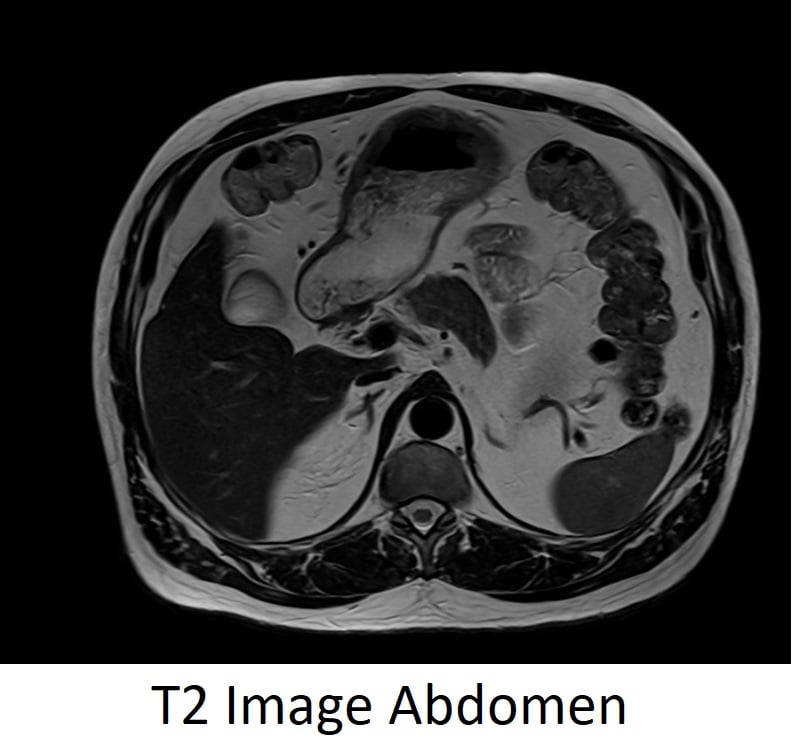
Magnetic Resonance Imaging (MRI) is a crucial modality in the diagnosis, characterization, and monitoring of various pathologies. One such pathology, chest thymoma, necessitates specialized attention due to its clinical implications. When evaluating chest thymomas, the differentiation between T1-weighted (T1) and T2-weighted (T2) MRI sequences becomes highly relevant. In this article, we shall delve into the importance of T1 VS T2 MRI image imaging in assessing chest thymoma and underscore the utility of each.
1. Anatomical Detailing with T1-Weighted Imaging
T1-weighted images predominantly showcase the anatomy of the region being scanned. For chest thymoma, T1 images can provide precise details about the tumor's size, margins, and its relation to adjacent structures (1). This aids clinicians in understanding the exact position of the tumor and its potential invasion into nearby tissues.
Reference:
Sakai S, Murayama S, Soeda H, et al. Thymic lesions: differentiation of thymic carcinoma from noninvasive thymoma, lymphoma, and mediastinal germ cell tumor at MR imaging. Radiology. 2001;221(1):191-196.
2. Tumor Characterization with T2-Weighted Imaging
T2-weighted images are of paramount importance when it comes to tissue characterization. Thymomas, being heterogeneous, can display varying intensities in T2 images, helping distinguish them from other mediastinal tumors or cysts. Additionally, T2 sequences might indicate necrotic or cystic components within the thymoma (2).
Reference:
2. Tomiyama N, Müller NL, Ellis SJ, et al. Invasive and noninvasive thymoma: distinctive CT features. Journal of Computer Assisted Tomography. 2001;25(3):388-393.
3. Detection of Fat Components
T1-weighted MRI sequences are sensitive to fat. Some thymomas, particularly those with lipid-rich content, will appear hyperintense on T1-weighted images. Recognizing this pattern is important, as it can differentiate thymomas from other pathologies or provide insights into the tumor's histological subtype (3).
Reference:
3. Inaoka T, Takahashi K, Mineta M, et al. Thymic hyperplasia and thymus gland tumors: differentiation with chemical shift MR imaging. Radiology. 2007;243(3):869-876.
4. Evaluating Tumor Invasion
Thymomas can potentially invade surrounding structures, including the chest wall, phrenic nerves, and great vessels. T2-weighted imaging, with its high contrast resolution, can be instrumental in evaluating the extent of such invasive behavior, informing the subsequent therapeutic approach (4).
Reference:
4. Aquino SL, Kee ST, Warnick P, et al. Diagnosis of anterior mediastinal masses with computed tomography: pitfalls and pearls. Chest. 1999;116(1):17-22.
5. Post-Treatment Monitoring
After therapeutic interventions like surgery or chemotherapy, both T1 and T2 MRI sequences offer substantial data on tumor response, recurrence, or potential complications. Monitoring treatment outcomes becomes vital in ensuring the patient's health and guiding future therapeutic choices (5).
Reference:
5. Marom EM, Milito MA, Moran CA, et al. Computed tomography findings of thymic carcinoma. Journal of Computer Assisted Tomography. 2001;25(6):905-910.
Conclusion
Both T1 and T2 MRI sequences hold significant diagnostic value in assessing chest thymoma. Their combined use offers a comprehensive view of the tumor, providing information that is critical for diagnosis, treatment planning, and post-treatment monitoring. As imaging technology evolves, the precision and utility of MRI in thymoma assessment are expected to further enhance, underscoring the importance of understanding and leveraging both T1 and T2 sequences.
